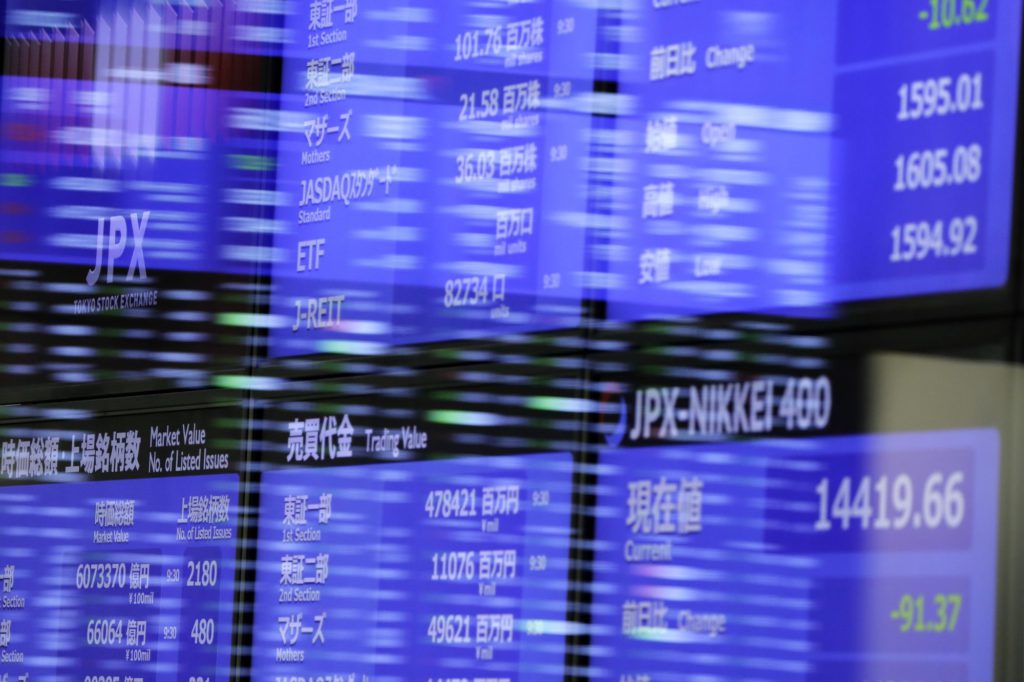Stocks climbed as Treasury yields halted a surge that drove them to multiyear highs, while an oil selloff eased concern about further price pressures that could imperil the Federal Reserve’s war against inflation.
(Bloomberg) — Stocks climbed as Treasury yields halted a surge that drove them to multiyear highs, while an oil selloff eased concern about further price pressures that could imperil the Federal Reserve’s war against inflation.
The S&P 500 rebounded from its lowest since mid-July, with every group but energy moving higher. At a presentation dubbed “Far Out,” Apple Inc. is set to unveil the iPhone 14 line, a fresh slate of smartwatches and new AirPods. West Texas Intermediate crude slumped below $85 a barrel. A dollar gauge was little changed after a rally that rattled currencies around the globe and briefly drove gold below the “danger zone” of $1,700 per ounce.
The pound slid to its weakest level in close to four decades, weighed down by a dire economic outlook. The Japanese yen dropped to a fresh 24-year low versus the greenback and speculation is swirling about the prospects for direct intervention. South Korea’s won weakened to levels not seen since 2009 and China’s yuan was within a whisker of cracking the psychological 7 barrier.
In the final week before officials enter a blackout period ahead of the Fed’s Sept. 20-21 policy meeting, a hefty lineup of central bankers will offer their views. Fed Bank of Cleveland President Loretta Mester warned against declaring early victory on inflation, saying she would like to see several months of declines in month-over-month readings before concluding that prices have peaked. The Beige Book due at 2 p.m. Washington time will be dissected for signs of moderating economic momentum.
“Is there a light at the end of the rate hike tunnel?” said Alex Christensen, portfolio manager at Columbia Threadneedle. “That’s what many investors are wondering on the heels of last month’s Fed symposium in Jackson Hole. And the answer to that question will depend on if the Fed believes it has done enough to bring down inflation.”
Traders pushed the market-implied odds of another three-quarter-point Fed rate increase in September — instead of a smaller half-point move — to the highest level since the central bank’s last meeting. The peak was reached shortly after a Wall Street Journal article suggested the larger move appeared likely. While it was only briefly sustained, the rate of the swap contract referencing this month’s meeting remains about two basis points higher on the day.
Equities have tumbled since mid-August amid a panoply of risks spanning from restrictive central banks, Europe’s energy crisis and China’s economic slowdown. The recent slide in the S&P 500 pared a bounce from June lows that a Goldman Sachs Group Inc. team led by Peter Oppenheimer described as a “bear-market rally.” The strategists “expect further weakness and bumpy markets before a decisive trough is established.”
Read: Burry of ‘Big Short’ Fame Says ‘No, We Have Not Hit Bottom Yet’
“Economies all around the world are slowing down, and that’s really not a market that says we’re on the verge of a dynamic rebound in equities,” Margaret Patel, senior portfolio manager at Allspring Global Investments, told Bloomberg Television. “Earnings are going to decelerate a lot. That says a lot of stocks could go down.”
The weakening economy should favor continued outperformance for cheaper, so-called value stocks over their growth equivalents, a separate Goldman note from strategists led by Cormac Conners said.
“History shows value stocks outperform around the start of recessions,” they wrote. Goldman economists forecast a one in three probability of a recession in the coming year.
Meantime, Wednesday’s plunge in oil was exacerbated by a bearish technical picture. The US oil benchmark formed a so-called death cross for the first time since February 2020, a pattern in which the 50-day moving average falls below its 200-day marker. Such a crossover typically signals a loss of short-term momentum and further selling pressure ahead, with prices remaining below their 50-day, 100-day and 200-day moving averages.
Elsewhere, wheat futures climbed almost 7% after Russian President Vladimir Putin criticized a recent grain deal with Ukraine, heightening attention on the sales outlook from the Black Sea region.
What to watch this week:
- European Central Bank rate decision, Thursday
- Fed Chair Jerome Powell due to speak, Thursday
- Chicago Fed President Charles Evans and his Minneapolis counterpart Neel Kashkari due to speak, Thursday
- EU energy ministers extraordinary meeting on emergency intervention in electricity markets, Friday
Are you bullish on energy-related assets? This week’s MLIV Pulse survey focuses on energy and commodities. Please click here to participate anonymously.
Some of the main moves in markets:
Stocks
- The S&P 500 rose 0.9% as of 11:31 a.m. New York time
- The Nasdaq 100 rose 1%
- The Dow Jones Industrial Average rose 0.8%
- The Stoxx Europe 600 fell 0.4%
- The MSCI World index rose 0.3%
Currencies
- The Bloomberg Dollar Spot Index was little changed
- The euro rose 0.4% to $0.9948
- The British pound fell 0.4% to $1.1472
- The Japanese yen fell 1.2% to 144.45 per dollar
Bonds
- The yield on 10-year Treasuries declined six basis points to 3.29%
- Germany’s 10-year yield declined six basis points to 1.57%
- Britain’s 10-year yield declined seven basis points to 3.03%
Commodities
- West Texas Intermediate crude fell 3.7% to $83.69 a barrel
- Gold futures rose 0.5% to $1,721.40 an ounce
More stories like this are available on bloomberg.com
©2022 Bloomberg L.P.











